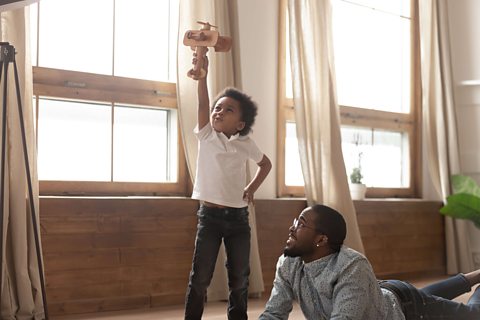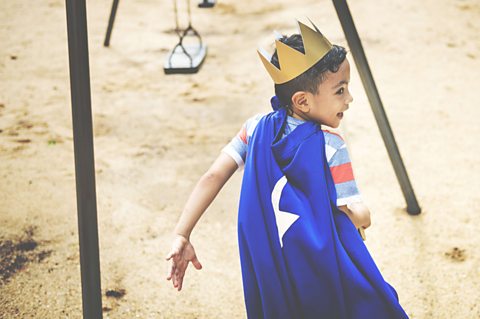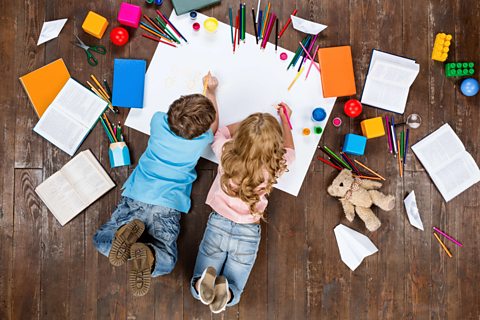
Humans have been telling stories to connect and communicate for thousands of years; they help us make sense of the world and our place in it, and are a fundamental part of what makes us human.
Storytelling also helps children develop the key skills they need to succeed at school.
To explore the importance of storytelling for children, we spoke to Kirsty Cunnington from the National Literacy Trust and writing specialist Pie Corbett.

How can stories help your child at school?
Storytelling is a powerful artform that inspires wonder in children and adults alike. Stories are also brilliant learning tools that teach us how to listen, concentrate and memorize important information.
Being able to retell a story, predict what happens next and discuss how characters feel are fundamental parts help us to develop our vocabulary and comprehension skills - all keys parts of the Reception curriculum.
Pie says, “If you want your child to do well in school, read to them, sing to them and tell them stories.”

Stories take us on adventures; from snowy mountains to dragon-guarded castles, stories are all about expanding our imagination. They help us move beyond our immediate surroundings and develop intellectual thought patterns.
Pie explains, "Children are able to develop abstract thought and start to imagine things that aren’t in front of them.”
This is a crucial skill that will support their learning across the curriculum, especially when it comes to maths. Numeracy is all about imagining numbers, symbols and patterns in our heads - and that imagination starts with storytelling.

Kirsty says, “Stories play a central role in developing a child’s emotional literacy; building resilience, empathy and compassion, and learning how to form strong bonds are among the most important skills a child can learn.
Understanding characters, their emotions and motivations, can help us get to grips with our surroundings and figure out how we feel. Kirsty explains, "Stories act as a kind of emotional blueprint for young learners. They help children make sense of people, build connections and understand what’s happening around them.”
How can I use storytelling at home?
Storytelling isn’t just about reading books at bedtime – although that’s a great place to start.
There are many fun, interactive and accessible ways to go beyond the page and weave storytelling into your everyday life at home.

1. Tell a story together
One way to start is by simply using the pictures on your phone. Kirsty suggests sitting down with your child and using the photos you’ve taken together to retell the story of the weekend or an exciting day out; maybe you went to the park or visited grandparents.
Find out what excites them and encourage them to talk about what you did, where you went and who was there. Did anything unusual or funny happen? How did it make them feel? Guide and support your child, but try and let them take the lead. They’ll delight in recalling their favourite moments and getting stuck into the narrative details of the story.

You could also build stories together by taking it in turns to say a sentence each. Kirsty says it’s a really simple but effective exercise that helps develop creative confidence.
Be sure to value their contributions – however silly! “Valuing what a child has to offer is really important.” Kirsty explains, "It’s important to make them feel heard, respected and validated.” Get older siblings involved too, or even grandparents; playing and building imagined worlds together is not only great fun, it also helps build and strengthen those crucial bonds.

Get older siblings involved too, or even grandparents; playing and building imagined worlds together is not only great fun, it also helps build and strengthen those crucial bonds.

2. Draw a story
Just because your child hasn’t started writing yet, that doesn’t mean they can’t kick off their careers as budding authors! Pie uses a technique call story-mapping, where children draw a series of pictures to tell a story. He explains, “It's a bit like an early form of writing.”
It might be a story your child already knows from school or one from your native culture or faith. It could even be one they’ve just made up. Use phrases like once upon a time, one sunny day, unfortunately, luckily, finally to help structure the story as you go.

Pie says “as they’re mapping out their story, don’t be afraid to ask questions about the characters, their relationships, feelings and emotions; why do you think they did that? Are they happy or sad?”
This helps them to really stop and think about their creations carefully, and get curious within a world they’ve designed themselves.
Once they’ve finished drawing their stories, help them write a sentence underneath each picture summarising what’s happened. Pie says, “You might even use it as their bedtime story!” It’s a great way to celebrate and validate their budding creativity.
3. Story bag
Another way you can flex those storytelling muscles is to use a bag of their favourite toys. Lay them out on the ground and, using a small rope and word prompts, you can start plotting our a story together.
It could be one of their own creation or a story they already know. It’s a great way for children visually see the flow of a narrative, connect with the characters and bring the world they’re building to life.

These are just some of the wonderful ways you can bring stories to life at home.
Storytelling is a brilliant skill that allows young learners to push the boundaries of their imagination and helps children to master those early learning goals. Nurturing play at home will develop the fundamental skills they need to thrive at school and beyond!
Play Bud's Number Garden game. game
Practise recognising numbers, counting, ordering and sequencing numbers

More on Parent support - English
Find out more by working through a topic